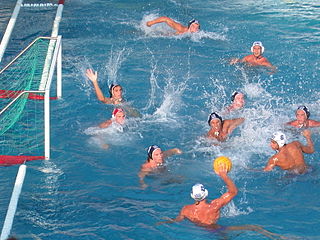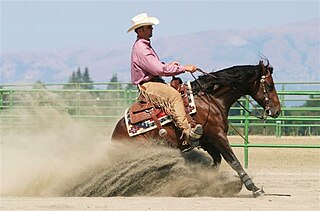
Lacrosse is a team sport played with a lacrosse stick and a lacrosse ball. It is the oldest organized sport in North America, with its origins with the indigenous people of North America as early as the 12th century. The game was extensively modified by European colonists, reducing the violence, to create its current collegiate and professional form.

Polo is a ball game played on horseback, a traditional field sport and one of the world's oldest known team sports. The game is played by two opposing teams with the objective of scoring using a long-handled wooden mallet to hit a small hard ball through the opposing team's goal. Each team has four mounted riders, and the game usually lasts one to two hours, divided into periods called chukkas or "chukkers".

Water polo is a competitive team sport played in water between two teams of seven players each. The game consists of four quarters in which the teams attempt to score goals by throwing the ball into the opposing team's goal. The team with the most goals at the end of the game wins the match. Each team is made up of six field players and one goalkeeper. Excluding the goalkeeper, players participate in both offensive and defensive roles. It is typically played in an all-deep pool where players cannot touch the bottom.

Equestrianism, commonly known as horse riding or horseback riding, includes the disciplines of riding, driving, and vaulting. This broad description includes the use of horses for practical working purposes, transportation, recreational activities, artistic or cultural exercises, and competitive sport.

Buzkashi is the national sport of Afghanistan. It is a traditional sport in which horse-mounted players attempt to place a goat or calf carcass in a goal. Similar games are known as kokpar, kupkari, and ulak tartysh in Kyrgyzstan and Kazakhstan.
Canoe polo, also known as kayak polo, is one of the competitive disciplines of kayaking. The sport is also known simply as "polo" by its players and supporters.

In sport, a goal may refer to either an instance of scoring, or to the physical structure or area where an attacking team must send the ball or puck in order to score points. The structure of a goal varies from sport to sport, and one is placed at or near each end of the playing field for each team to defend. For many sports, each goal structure usually consists of two vertical posts, called goal posts, supporting a horizontal crossbar. A goal line marked on the playing surface between the goal posts demarcates the goal area. Thus, the objective is to send the ball or puck between the goal posts, under or over the crossbar, and across the goal line. Other sports may have other types of structures or areas where the ball or puck must pass through, such as the basketball hoop. Sports which feature goal scoring are also commonly known as invasion games.

Reining is a western riding competition for horses where the riders guide the horses through a precise pattern of circles, spins, and stops. All work is done at the lope, or the gallop. Originating from working cattle, reining is often described as a Western form of dressage riding, as it requires the horse to be responsive and in tune with its rider, whose aids should not be easily seen, and judges the horse on its ability to perform a set pattern of movements. The horse should be willingly guided or controlled with little or no apparent resistance and dictated to completely. A horse that pins his ears, conveying a threat to his rider, refuses to go forward, runs sideways, bounces his rear, wrings his tail in irritation or displays an overall poor attitude is not being guided willingly, and is judged accordingly.

Polocrosse is a team sport that is a combination of polo and lacrosse. It is played outside, on a field, on horseback. Each rider uses a cane or fibreglass stick to which is attached a racquet head with a loose, thread net, in which the ball is carried. The ball is made of sponge rubber and is approximately four inches across. The objective is to score goals by throwing the ball between the opposing team's goal posts.

A polo pony is the term used for a horse used in the game of polo. They may be of any breed or combination of breeds, though many have a significant amount of Thoroughbred breeding. They are called "ponies", but that is a reference to their agile type rather than their size; almost all are horse-sized. They require considerable training and ongoing conditioning, and because each rider requires at least two horses in a single match, this can be a considerable expense. When playing, polo ponies have their manes roached and tails braided so that there is no danger of being tangled in the mallet.

Cycle polo, bicycle polo, or bike polo is a team sport, similar to traditional polo, except that bicycles are used instead of horses. There are two versions of the sport: Hardcourt Bike Polo and grass court bike polo. The hardcourt game saw a sharp spike in interest in the first decade of the 21st century and new teams are sprouting up across the world in China, Canada, Ireland, Switzerland, France, India, Germany, Pakistan, Ukraine, Russia, Malaysia, Sri Lanka, Indonesia, Hungary, Australia, New Zealand, Sweden, England, Scotland, Argentina, Italy, Spain, USA, Poland, Croatia, Slovenia, Lithuania, Nepal, Brazil and Cuba.

Horseball is a sport played on horseback where a ball is handled and goals are scored by shooting it through a hoop with a diameter of 1m. The sport is a combination of polo, rugby, netball, and basketball. It is one of the ten disciplines officially recognized by the International Federation for Equestrian Sports.

Segway polo is a team sport which started to gain some measure of popularity after being played by members of the Bay Area Segway Enthusiasts Group in 2004. The Bay Area SEG was not the first to play polo on a Segway HT; a team sponsored by Mobile Entertainment played in the Hubert H. Humphrey Metrodome at a Minnesota Vikings halftime show in 2003 although the Bay Area SEG members were not aware of this match at the time they first played the sport. Segway polo was developed as it is played today by the members of the Bay Area SEG and other groups and teams that have joined subsequently.

Hardcourt Bike Polo is a variation of traditional Bicycle Polo in which teams of players ride bicycles and use mallets to strike a small ball into a goal. It may also be referred to as "Hardcourt", "Urban Bike Polo" or simply "Bike Polo".
Jereed is a traditional Turkish equestrian team sport played outdoors on horseback in which the objective is to score points by throwing a blunt wooden javelin at opposing team's horsemen. Played by Turkic peoples in Central Asia as the essential sporting and ceremonial game, it was brought to Anatolia during the westward migration in the beginning of the 11th century.
Arena polo is a fast-paced version of polo played outdoors on an enclosed all-weather surface, or in an indoor arena. Hurlingham Polo Association and US Polo Association have established their own rules for arena polo, and these rules are often used in other countries as well.

India is the birthplace of modern polo. The modern game of polo is derived from Manipur, where the game was known as 'Sagol Kangjei', 'Kanjai-bazee', or 'Pulu'. It was the anglicised form of the last, referring to the wooden ball that was used, which was adopted by the sport in its slow spread to the west.

Automobile polo or auto polo was a motorsport invented in the United States with rules and equipment similar to equestrian polo but using automobiles instead of horses. The sport was popular at fairs, exhibitions and sports venues across the United States and several areas in Europe from 1911 until the late 1920s; it was, however, dangerous and carried the risk of injury and death to the participants and spectators, and expensive damage to vehicles.

Chovgan, Chowgan or Chogan, is a sporting team game with horses that originated in ancient Iran (Persia). It was considered an aristocratic game and held in a separate field, on specially trained horses. The game was widespread among the Asian peoples. It is played in Iran, Republic of Azerbaijan and among Tajiks and Uzbeks.
Hobby horse polo is a mixed team sport played on hobby horses. It is similar to other polo variants, such as canoe polo, cycle polo, camel polo, elephant polo, golfcart polo, Segway polo, auto polo, and yak polo in that it uses the basic polo rules, but it has its own specialities.















